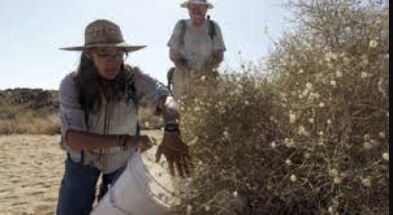Wildflower Revival: Southern California's Stunning Comeback Sparks Conservation Efforts
Massive winter downpours have brought rare desert flowers back to Southern California, prompting efforts to collect and store seeds for the future and undertake restoration projects to protect fragile ecosystems from wildfires.
Flowers that haven't been seen in years have made a stunning comeback across Southern California this spring, thanks to massive winter downpours. These blooming landscapes not only provide a visual delight but also present a valuable opportunity for conservationists.
With the threat of a hotter and drier future due to climate change, gathering seeds from these rare desert plants has become crucial for building seed banks and undertaking restoration projects. In the Mojave Desert, staff and volunteers are working tirelessly to collect seeds from plants like parish goldeneye and brittlebush.
These seeds will be stored in seed banks and used for future restoration efforts. The recent York Fire, which ravaged the Mojave National Preserve and destroyed thousands of acres, including iconic Joshua trees, has further emphasized the need for proactive seed banking as a fire management tool. Wildfires have become more common in the West and pose a significant risk to both human lives and the environment.
Invasive grasses, which quickly fuel flames, have contributed to the spread of wildfires in desert landscapes like the Mojave. Seed banking is not a new concept in the United States. Initially, it focused on preserving rare and exotic plant species. However, with the increasing risk of wildfires and the proliferation of invasive species, efforts are now aimed at collecting seeds from commonly found plants as well.
The process of seed collection is labor-intensive and time-consuming. Volunteers in Joshua Tree, California, survey hiking trails during the blooming season to map the locations of plants. When the seeds are ready to be harvested, they return to collect them. The seeds are carefully cleaned, labeled, and stored in jars in refrigerators.
The Mojave Desert Land Trust is expanding its seed collection efforts in response to recent wildfires and is grateful for grant funding to support these endeavors. Seed banking is not just limited to California. It is a nationwide program that aims to store seeds for long-term use in restoration projects.
However, despite increased funding for the program, the demand for seeds far exceeds the available supply. In California alone, there are over 4,000 seed collections representing more than 1,300 plant species. This accounts for only a fifth of the state's known plant species, highlighting the need for more extensive seed banking efforts.
Fortunately, this year's wet winter in California has created a golden opportunity for seed banking. The Chicago Botanic Garden has tripled the number of seed collectors in Western states compared to last year. The Bureau of Land Management is also ramping up its seed collection efforts in the Mojave Desert region.
However, one challenge is the vastness of the area, making it crucial to collect seeds from the same location for effective restoration. The need for restoration efforts is not unique to the West, but the scale is much greater due to the size and severity of wildfires in the region. As our climate continues to change, places that were once considered safe from wildfires now require restoration.
The Mojave Desert, for example, was not prone to wildfire problems 30 years ago. This change necessitates proactive measures like seed banking to help preserve and restore these valuable ecosystems. Overall, the recent resurgence of flowers in Southern California serves as a reminder of the importance of seed banking and restoration efforts in the face of a changing climate.
Gathering seeds from diverse plant species is crucial for protecting our natural landscapes and ensuring their resilience in the future. With continued support and funding, conservationists hope to expand seed collection efforts and restore the fragile ecosystems that have been impacted by wildfires.





